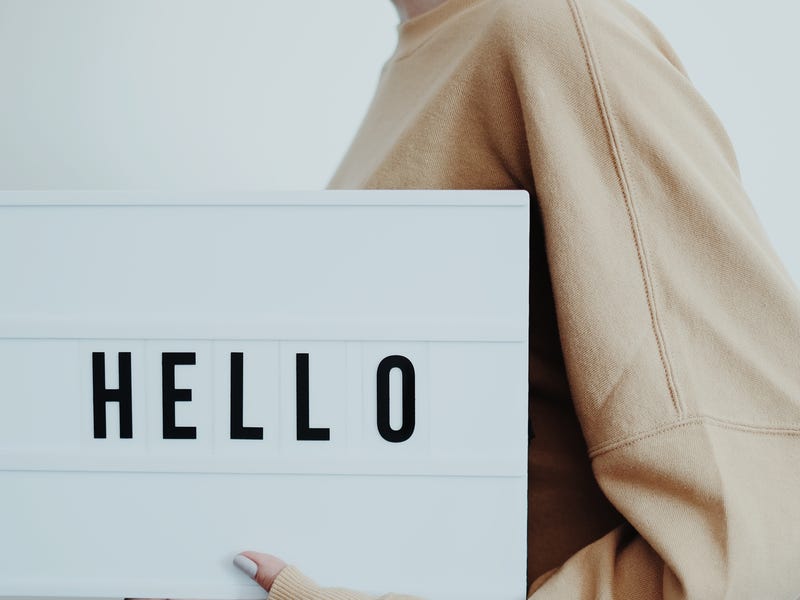While language is a key part of communication — tell us about it at Berlitz! — it’s not the only one. Non-verbal language and cultural etiquette are also essential to conveying a message efficiently. And guess what? They can also be learned.
In this article, we’ll tell you almost everything — you’ll have to experience the rest! — on American manners and etiquette. Handshakes, small talk, tipping math, dining and personal space—we've got you covered. And don’t worry, there are things to know, but Americans are usually pretty straightforward and friendly.
Whether you're visiting or just curious about the unspoken rules of American etiquette, this guide will help you through interactions with (amazing) grace. After all, when in America, do as the Americans do!
Table of contents
- Greetings and introductions in the US
- The basics of American politeness and conversation
- Dining etiquette in the United States
- Personal space and boundaries
- Punctuality and time management etiquette in America
- American manners and public behavior
- American work etiquette
Greetings and introductions in the US

Importance of handshakes
Let’s kick it off with the great American handshake, which can sometimes be very… energetic! In the US, handshakes are the gold standard for first impressions if you’re not ready to enter the hug zone just yet or if you’re in a professional environment. Speaking of which, check out our guide to American work culture and business etiquette!
A good handshake should be firm — your hand is alive! — but not bone-crushing. You’re aiming for confidence, not dominance. Ah, and also, don’t linger (not sorry for the video). Make eye contact, smile, and give a solid two to three pumps before letting go. And keep things simple — no fist bumps or secret handshakes unless you’re at a middle school reunion.
Casual greetings
Now, what about when you’re not in a formal setting? Casual greetings in the US are relaxed and often informal. A friendly “Hi” or “Hello” with a quick hug is standard, though depending on the region, you might hear “How’s it going?” (Translation: You don’t actually need to answer how it’s going).
While “Good morning/afternoon/evening” can be a bit more formal, they’re still totally acceptable pretty much anywhere, especially in service settings. Americans tend to appreciate the friendly, familiar vibe, so feel free to greet your barista with a cheerful “Hey!”
And if you want to spice things up, here are 107 different ways to say hello in English!
Ah, and to my fellow French readers: “la bise” is absolutely not common and even considered weird in the US, so stick to a handshake or a hug depending on the situation.
Smiling and eye contact in social settings
One of the main reasons why I love the US so much is people’s kindness. Obviously, I’ve met your typical grumpy cab driver in large cities, but overall, in America, smiling is as common as pumpkin spice in fall — no comment on that one.
People smile at each other on the street, in grocery stores, and even during awkward elevator rides. It’s a sign of friendliness and approachability. When you pair that with eye contact, you’ve got yourself a winning combination for social success, as honesty is highly valued. Not too much, though — it’s not a staring contest!
At social gatherings, a smile and some light eye contact go a long way in making connections. It signals that you’re engaged and open to conversation. Try to avoid looking away too often, as that can come across as disinterested.
Use of first names
As a French person — where your last name is used a lot — I really enjoy that Americans are on a first-name basis quickly, especially in casual settings.
You might meet someone, exchange a couple of jokes, and boom — you’re using their first name. Of course, in professional environments, it’s usually best to stick with Mr., Mrs., or Dr. unless told otherwise. When in doubt, let the other person set the tone and go with the flow!
What to avoid when it comes to greetings and introductions etiquette in America
The US is home to a melting pot of cultures and people are pretty open-minded, so don’t worry too much about etiquette faux pas. That being said, a couple of things should be avoided.
First off, don’t be overly formal. Overusing titles like Sir or Madam can make you seem cold and stiff. Avoid intense or very soft handshakes, and use physical contact sparingly. For example, it’s probably not a good idea to hug someone you’ve just met. Lastly, no need to bow or curtsy unless you’re in a historical reenactment society!
The basics of American politeness and conversation

Please and thank you
In practically any culture, these two little words are like magic. However, in the US, they take a whole other dimension. They’re a must in American politeness, and absolutely necessary to show respect.
If you’re asking for anything — a coffee, directions, a favor — throw in a “please.” When someone does something for you, whether big or small, don’t forget a cheerful “thank you!”, and don’t hesitate to add a touch of American enthusiasm with “a bunch”, “a lot”, “a million”!
You’ll find lots of ways to say “please” and “thank you” in English in this article.
Apologizing
As a French person, I’m always amazed at the use of “sorry” in the US. People use it literally every 5 minutes, even when they have nothing to apologize for and when it’s not their fault!
Interrupt someone involuntarily? “Sorry!” Bump into someone in a crowded space? “Sorry!” Didn’t hear what someone said? “Sorry, could you repeat that?” Minor inconveniences often call for quick apologies, but here is a guide to apologizing in English if you need something more elaborate — like this.
Small talk
Ah, small talk—the lifeblood of American social interaction. In fact, many Americans feel awkward when there’s silence in the conversation!
If you’re not used to small talk — you might be from a Nordic country? — it might feel odd at first, but don’t worry, it’s easier than it seems. Weather, sports, local events and restaurants, definitely restaurants — these are all great topics for casual conversation starters.
You don’t need to get too deep right away. Keep it breezy. If you’re at a party and someone brings up the latest NFL game or the crazy weather, congrats! You’re in the middle of classic American small talk. And to our Nordic readers, don’t be scared, people can be loud and it’s normal!
Here’s a full guide to small talk for you in case you need inspiration.
Controversial topics to avoid in casual conversations
While Americans are usually very open, it might be best to avoid a few topics. For example, politics, religion, or anything too personal are not appropriate when you’re just getting to know someone.
Save those conversations for when you’re in a more comfortable setting, with close friends or family. And know your audience!
What to avoid when it comes to conversation etiquette in America
Most Americans are super easy to talk to. However, avoid interrupting people while they’re speaking — apologize if you do — and let the other person talk as much as you do. Americans appreciate when conversations flow naturally, without one person dominating the dialogue.
Also, oversharing personal details too quickly can make things a little uncomfortable — you know, TMI! (too much information).
Dining etiquette in the United States

American tipping etiquette
American tipping etiquette is very difficult to understand for Europeans and other nationalities when they first visit the US!
First of all, it’s important to know that tipping is not included in people’s wages, especially in the service industry. So, in the US, tipping is mandatory, not just a nice gesture if you’re happy with your waiter — and chances are you’ll be, as most are super friendly and professional.
In restaurants, tipping 15-20% is standard, and for excellent service, go closer to 20%. If you leave anything less than 15%, you’ll be considered as a bit cheap. If the service was exceptional, feel free to go above. For quick, counter-service places, tipping isn’t required, but it’s nice to throw something in the jar.
American table manners and etiquette
Food is an essential part of American culture, so it’s a good idea to learn the basic American table manners etiquette!
In a restaurant, wait until everyone is served before digging into your food. At someone’s place, people usually start eating right away — trust me, if you don’t, the food will be gone. In doubt, you can ask the host!
Use your utensils properly (no shoveling!) — or your hands depending on what you’re eating — and chew with your mouth closed. Napkins go in your lap, and elbows should stay off the table, especially in formal settings.
Finally, it’s polite to ask someone to pass an item rather than reaching across the table.
Casual dining vs formal settings
The vibe at an American dinner table can range from a casual taco night with friends to a black-tie gala.
At casual spots, you can be very relaxed. In fact, you’ll see many people going to dinner with comfy sneakers, jeans and a hoodie. If you’re invited to someone's place, food might be served as a self-service buffet and not directly on the table. This is very common for barbecues or boils!
In formal settings, it’s important to mind your manners and dress the part. Think nice outfits, proper posture, and following the host’s lead on what to order and when to start eating.
What to avoid when it comes to dining etiquette in America
Again, it all depends on the context. However, in general, don’t chew loudly, speak with our mouth full, or reach across the table.
Avoid playing with your phone during dinner — it’s considered rude to focus on your screen rather than the people you’re with, but I think it’s pretty much universal.
If someone offers to pay, insist on paying as well but don’t fight it for too long. You can offer to pay next time, for example, or offer to cover the tip.
Speaking of which, don’t forget to tip! Skipping this is a major faux pas and very disrespectful to the person who served you.
Personal space and boundaries

Respecting personal space
Americans value personal space — I love that; it’s so underrated! In conversations, on the street or in a waiting line, standing too close might make the other person uncomfortable.
A good rule of thumb? About an arm’s length is usually an appropriate distance for casual conversation. Crowded places, like public transport, might call for a little compromise, but in general, giving people space will be appreciated.
Touching
While they love their personal space, Americans are generally pretty “touchy”. It’s very common to pat people on the back or hug.
Of course, it’s best to stick to handshakes when you first meet someone. If you’re unsure, let the other person initiate any extra touch. And always read the room depending on the context!
If you do hug, it’s usually some kind of half hug on the side and not the full-on embrace. Just practice, you’ll get a hang of it quickly!
What to avoid when it comes to personal space etiquette in America
Super important: don’t go too close or touch someone without their consent. Unwanted touching can feel intrusive when you don’t know the person well and/or if you’re in a business environment.
In doubt, stay on the side of caution and keep your hands to yourself unless you’re sure physical contact is welcome or until the other person has initiated it.
Punctuality and time management etiquette in America

Importance of being on time
In the US probably more than anywhere else, time is money. But being punctual is also a sign of respect, and I personally love that!
Whether it’s a work meeting or a social event, arriving on time shows that you value the other person’s time. If you’re running late — it happens! — make sure to let them know in advance.
Lateness in work vs casual meetups
While being late to work meetings is considered as really rude and unprofessional, casual meetups with friends have a bit more flexibility.
That said, keeping people waiting too long is still impolite. If you’re running behind, just make sure to send a quick text or voice message.
Appointments and RSVPs in America
When invited to an event, make sure to RSVP as soon as you know if you’ll be coming or not. This helps the host plan accordingly, and is, again, a sign of respect.
For appointments — especially business ones — show up on time or reschedule with enough notice if you can’t make it.
What to avoid when it comes to punctuality etiquette in America
In some cultures, being late is actually accepted and sometimes even polite.
However, this is not the case in the US! Being late gives the impression that you’re unreliable and that you don’t respect other people. Also, don’t put aside that wedding invitation before sending a RSVP! It’s a simple way to show respect for the host’s time and effort. If you’ve ever hosted something, you’ll understand.
American manners and public behavior
In general, the key to appropriate public behavior in the US is being mindful of those around you. Below are a few examples.

Quietness in public spaces
If you're in a library, a waiting room, or even a coffee shop where people are working, keep your volume down. Americans appreciate when people respect the shared environment. In other settings, speaking loudly is OK — this doesn’t mean shouting, though. Basically, save your lovely, energetic voice for outdoor spaces or social settings!
Respecting queues
Queue-jumping isn’t an American sport. In fact, it will bring you some seriously angry looks. Yep, waiting your turn is a crucial part of American etiquette.
Whether you’re in line for a coffee, concert tickets, or the latest best-selling book, cutting in line is a big no-no. Be warned! (yes, I’m talking to you, fellow French people)
Use of cell phones in public
Cell phones have brought one of the biggest etiquette challenges in modern times: How to handle your phone in public. In the US, keep your phone conversations low and brief when you're out in public.
Avoid loud, personal conversations, and if you're in a confined space like a bus or metro, try to wait until you're somewhere more appropriate to take calls.
If you're in a meeting, a restaurant, at the movies or attending an event, put your phone on silent and take any call outside if you absolutely have to answer.
American work etiquette

Professional greetings
I’ve always been impressed at how Americans like to keep things professional but approachable. To me, it’s the perfect balance!
As mentioned, a firm handshake and direct eye contact are the norms in business settings. Formalities like “Mr.” or “Ms.” can be used when appropriate, but first names are usually OK once you’ve been introduced. This goes when talking or writing an email.
Always try to make a good first impression — that is, professional but friendly — whether it's your first day at the office or a new client meeting.
Office hierarchies
American workplaces can have both formal and informal hierarchies. While respecting seniority is important, the American work culture also tends to have open-door policies and flat structures in many companies. I really appreciate how Americans don’t see informality and friendliness as disrespectful and unprofessional.
That being said, it doesn’t mean you can do anything. You might address your boss by their first name, but it’s always best to assess the culture of the workplace before using casual terms. Formal communication is best in certain industries or settings, so make sure to know the office vibe before ditching the formalities.
Professional etiquette in meetings
Ah, it’s time for my dear punctuality to pay us another visit! In meetings, punctuality is key. Arriving on time — or even better, five minutes early — shows respect for everyone’s schedule.
During the meeting, stay engaged, take notes, and actively participate. Questions are usually welcome, but you might want to save them for the end. Don’t interrupt others when they’re speaking, and make a point to follow up on any action items or tasks assigned to you afterward.
Working remotely? Zoom and virtual meetings have their own etiquette — dress appropriately (yep, even the bottom part in case you need to stand up to kick your cat out), check your background, mute yourself when not speaking, and avoid multitasking.
What to avoid when it comes to work etiquette in America
In American business, the big no-nos are showing up late or unprepared to meetings, dominating conversations, not following up or neglecting to respond to emails or address issues in a timely manner.
In a professional setting, respect for others’ time and contributions is crucial. If you can’t meet a deadline, make sure to give plenty of heads up and a valid reason.
Gossiping about coworkers or being too informal with senior colleagues can be seen as unprofessional.
Finally, and it should be common sense, never show disrespect, especially regarding things like gender or religion. To go deeper on the subject, take a look at our guide to American work culture and business etiquette!
Ok, this might seem like a lot, but don’t worry. Americans are usually super approachable and easy going. They’re not difficult to talk to, and they’re very patient if you don’t dominate English just yet. They also love when visitors show interest in their culture, so don’t be afraid to ask (appropriate) questions.
American manners and etiquette aren’t just about following rules — they’re about showing respect for those around you.
So, as you explore the world of American politeness, don’t forget to smile, say “please” and “thank you,” and maybe add in a pun or two (as long as they’re good). You’ve got this!
And if American culture is fascinating to you, check out our article on American business etiquette and American cuisine.



